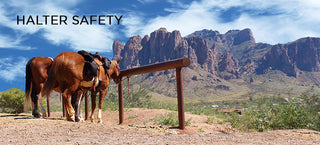There seems to be some confusion about halters and breakaway safety - why you would want your halter to breakaway and why you wouldn't, as well as the related topic of tying.
What is a halter safety breakaway?
Simply put, it is having some part of your halter that will break before your horse's body does. This helps prevent both minor and catastrophic injuries. Certain organizations like Pony Club will also have gear requirements for this safety feature.
But won't my horse get away if the safety breakaway is triggered?
A loose horse is better than a dead horse or one severely injured. Pull back injuries in particular can lead to lacerations and even injury to your horse's vertebrae.
A word about turnout...
I don't personally recommend ever turning a horse out in a halter, but in some stabling situations, this could be a requirement or necessity. It would be an ugly situation if your horse caught a shoe on his halter or his halter on a fence. You should NEVER turn out a horse to pasture with a halter on unless:
- You are using a leather halter
- You are using a nylon halter that has a breakaway fuse or poll strap
And a few words about rope halters...
NEVER, EVER, EVER turnout a horse in a rope halter.
NEVER, EVER, EVER cross tie a horse in a rope halter.
If a horse pulls back in a rope halter, it will tighten. Nothing will break. If you are not there to cut him out of it with a knife or release the rope he is secured to his body will be what breaks.
How do I know if my halter is a "breakaway"?
Any halter advertised as a breakaway will have this capability. So will leather halters with an all leather poll strap, because leather is a naturally breakable material when placed under enough pressure thanks to seams and natural fiber weaknesses. Synthetic materials like nylon are designed for strength and to hold pressure, so do not provide this breaking safety.
You can adapt any nylon or synthetic beta halter to be a safety breakaway halter with our Breakaway Fuse Kit.
Our HEC halters are built with a throat latch snap which provides another layer of protection in a pullback, this snap is designed to fail under enough strain but it takes A LOT of force. This is snap failure safety is not enough for pasture turnout and is a backup safety feature only.
Other safety practices
Another safety policy I recommend is using a Blocker Tie Ring anywhere you tie your horses; cross ties, wash bay, trailer, etc. These are not "cheap as chips" but they are cheaper than a vet bill or injury and in my opinion, essential to your stable. What I like most about them is they will protect you and your horse from projectile injuries from whatever you are tying the horse to breaking. It allows the lead rope to slide, while keeping your horse safely secured. This greatly reduces the strain on rings or bolts that we tie horses to - many of which have not been maintained in years and are just waiting for extraordinary force to break. Some metals are also prone to breakages in frigid temperatures, so the tie ring also reduces that potential risk.
Knowing knots can be very helpful and a great horsemanship skill, however not all of us are 'knotty' kind of people which is okay. The right tack and safety devices can bridge that gap in ability or knowledge while keeping you and your horse safe.
When it comes to tying horses, I believe in having several safety redundancies - its like having your young kids around live electricity or guns - safety, safety, safety.

